The oryx, known as the gemsbok, is an antelope native to Africa and parts of the Arabian Peninsula. It is a large species with distinctive horns extending up to two feet in length. The animal has been hunted for centuries due to its size and strength, making it both an iconic symbol of African wildlife and one of the conservationists’ greatest challenges. This article will discuss this remarkable species’ ecology, behavior, and conservation status.
Oryx are herbivorous animals typically found in arid grasslands or savannahs. They have several defining characteristics, including a broad muzzle, long black-and-white legs, sharp hooves adapted for running on hard terrain, and thick fur, which protects them from extreme temperatures. Oryx feed mainly on grasses but may occasionally consume shrubs if necessary. When food is scarce, they have also been known to dig into the ground for roots and tubers.
Due to their large size and impressive horns, oryx are highly sought after by hunters worldwide, leading some subspecies populations to become endangered over time. Conservation efforts such as habitat protection zones have been implemented in many areas. However, much work still needs to be done if this unique African mammal is to survive into future generations. This article will explore these issues in greater depth while examining possible solutions through research initiatives currently underway around the globe.
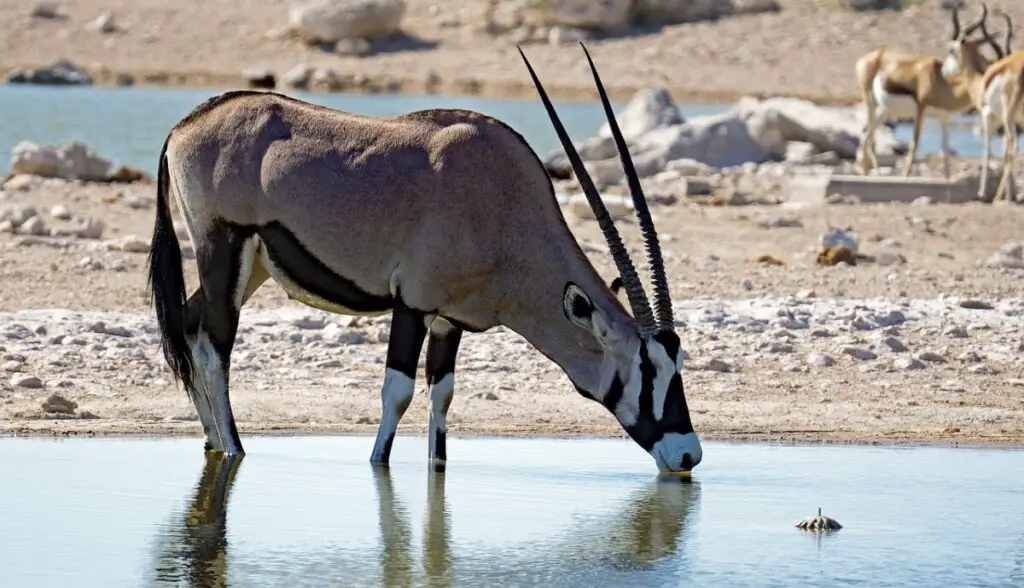
What Kind Of Animal Is An Oryx?
An oryx is an antelope found in different parts of the world, such as Africa and Arabia. They are large animals with long horns on their heads, which distinguishes them from other species. Oryx typically live in desert regions and grasslands, where they feed on shrubs and small plants.
Oryx have adapted to their environments by developing certain features like hooves for walking through rough terrain. They also use their horns for defense against predators. They can survive without water for extended periods due to their efficient kidneys and digestive system.
From an evolutionary standpoint, this animal has proven capable of surviving in harsh conditions while maintaining its distinctive characteristics. This has enabled it to remain relevant among other members of the antelope family despite changes in climate and habitat.
Where Do Oryxes Live?
Oryxes, also known as gemsboks, are antelopes that inhabit the dry lands of Africa and Arabia. They can be found in open grasslands or deserts, where they get most of their water from plant roots and dew. Oryx populations vary greatly depending on the environment they live in. At the same time, some areas may support large herds, other regions will have a much smaller population due to a lack of food or water sources.
Oryxes are well-adapted for desert life thanks to their long legs and broad hooves, allowing them to easily walk across sandy terrain. Their diet consists primarily of plants such as acacia leaves and pods, though they will occasionally hunt animals like hares if no vegetation is available. These antelopes often take shelter under the shade of trees or bushes to stay cool during hot days. The presence of an oryx in an area indicates good health: its ability to survive in harsh conditions means it has access to adequate food and water resources.
The conservation status of oryxes varies by species; while some subspecies are listed as endangered due to hunting pressure, others are considered common and abundant throughout their range. Conservation efforts such as habitat protection and anti-poaching measures have helped increase the numbers of certain species over recent decades. Nevertheless, ongoing threats posed by human activities like land conversion remain a concern for all members of this unique family.
How Big Is An Oryx?
Oryxes, also known as gemsboks, are large antelopes native to Africa and the Middle East. They can be distinguished by their black-and-white markings on the face, long legs, and long horns that curve backward. The size of an oryx can vary depending on where it lives; for example, the Arabian oryx is smaller than the African oryx.
Oryxes typically grow to around 1.2 meters in length from head to tail, with a shoulder height ranging from 80 cm to 1 meter. Males tend to be larger than females and have longer horns; both sexes weigh between 90 kg and 140 kg when fully grown. Additionally, males are darker in color than females due to greater melanin production during development.
The average life span of an oryx in captivity is up to 20 years, but wild individuals often only live for about 10 years due lack of food sources and predation risk. Adult oryxes usually avoid predators such as lions and cheetahs through their speed and agility while running at speeds of up to 70 km/h over short distances.
What Does The Name Oryx Mean?
The name oryx is derived from the Greek word for “moon” and was given to this antelope species due to its large curved horns that resemble crescents. This genus of antelopes includes four different species, namely: Arabian Oryx (Oryx leucoryx), East African Oryx (Oryx beisa), Scimitar-horned Oryx (Oryx dammah), and Gemsbok (Oryx gazella). These animals are generally found in dry regions such as deserts, steppes, savannahs, and semi-deserts; they often avoid dense vegetation because it hides potential predators.
The morphology of these animals is quite distinctive; their bodies feature a white coat with black stripes along their neck, while males typically have long horns curled into a semicircle shape. They also possess specialized glands on their legs which help expel waste salt; this adaptation allows them to consume salt water without getting sick. In addition, they can go without drinking water for weeks and survive by deriving moisture from plants like grasses, leaves, and fruits.
These animals usually travel alone or in small groups. Still, during drought, they form larger herds consisting of up to 20 individuals who come together in search of food and water sources. Their diet consists mainly of grasses, roots, and leaves, although occasionally, they may feed on insects if necessary. Despite being primarily herbivores, oryx are capable hunters when needed; they use their sharp hooves to defend themselves against predators by kicking back with great force.
What Animal Group Is An Oryx?
The oryx, also known as a Gemsbok, is an antelope of the species Oryx gazella. This animal can be found throughout different African regions, including Namibia, Botswana, and South Africa. It typically lives in semi-arid habitats such as savannas and deserts but has been seen inhabiting other areas when resources permit it. The body structure of the oryx makes it perfectly adapted to its environment—it has long horns that are used for protection from predators and thick fur coats which help keep them cool during hot days.
Regarding diet, the oryx feeds mainly on grasses, herbs, and shrubs but will supplement their nutrition with fruits, bulbs, and roots if available. They tend to stay near water sources to get hydrated but have been observed going far distances to find food when needed. This antelope can survive without water for several days due to its efficient digestive system; it stores moisture within its cells rather than drinking it directly from a source.
Oryxes form small herds consisting mostly of females that take turns watching over each other’s young while the males remain solitary or roam around searching for mates. When threatened by potential predators like lions or cheetahs, these animals usually flee instead of fighting back due to their lack of physical strength compared to some other African wildlife species. However, working together as a herd, they become more aware of the danger, allowing them to quickly escape any threatening situation before harm comes to them.
Can An Oryx Kill A Lion?
The Oryx, also known as gemsbok or South African antelope, is a large antelope native to Africa. Due to their large size and impressive horns, they are often considered an apex predator in the savanna ecosystems where they live. As such, it begs the question: can an oryx kill a lion?
One must first understand both animals’ abilities and behaviors to answer this question. Lions are powerful predators that usually hunt in groups; however, when faced with a single animal like an oryx, lions will typically not engage unless provoked by the oryx. On the other hand, oryxes have been observed charging toward lions if feeling threatened. This behavior has allowed them to successfully fend off threats from large carnivores on multiple occasions.
In light of these observations, evidence suggests that an oryx could potentially kill a lion under certain circumstances. However, due to their social nature and sheer strength combined with numbers, it is more likely that a pride of lions will take down an individual oryx than vice versa. Therefore, while predation events between these two animals occur occasionally depending on context and circumstance, they remain relatively rare.
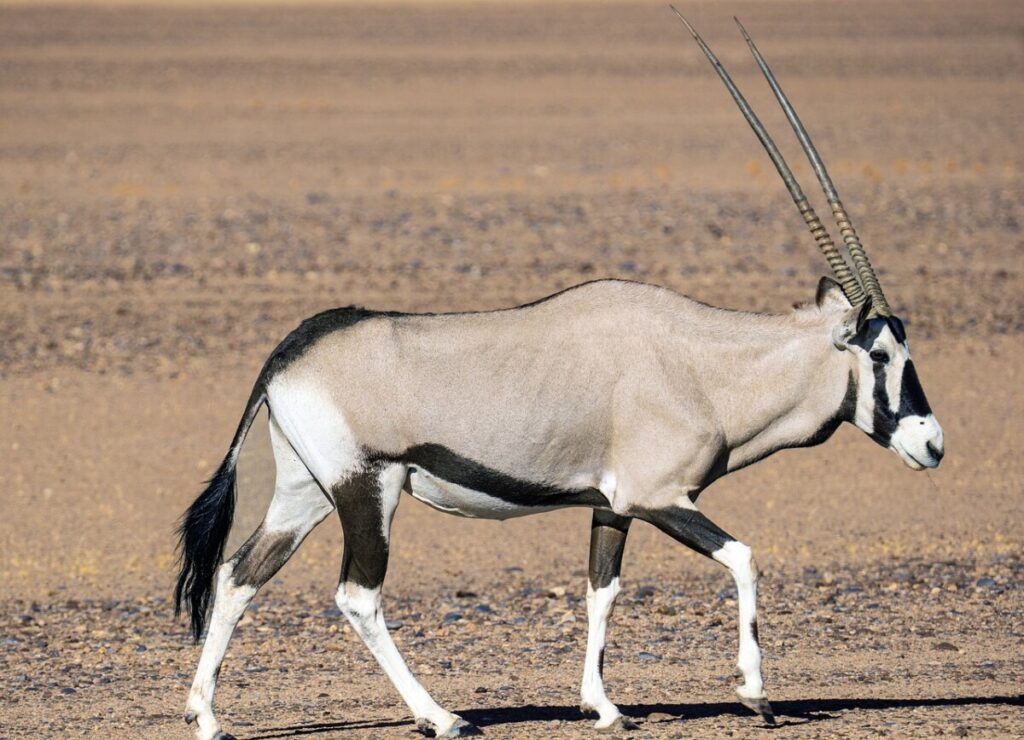
Arabian Oryx
The Arabian oryx (Oryx leucoryx) is a large antelope native to the Middle East and North Africa. This species has been listed as endangered by the International Union for Conservation of Nature since 2011 due to threats from hunting, habitat loss, and poaching.
Physical characteristics of the Arabian oryx include white coats with black markings on their legs, necks, shoulders, and faces. Both males and females have horns that can reach up to 1 meter in length. They also possess unique adaptive capabilities; they can survive long periods without water thanks to their thick fur, which helps them retain moisture.
Arabian oryx are social animals living in herds led by dominant males protecting them against predators such as lions and hyenas. These animals roam over vast distances searching for food sources, including grasses, leaves, fruits, insects, and small reptiles. The Arabian Oryx was once widespread throughout its range but now only exists in several isolated populations due to human pressure causing significant population decline. Conservation efforts must be implemented if this species survives into future generations.
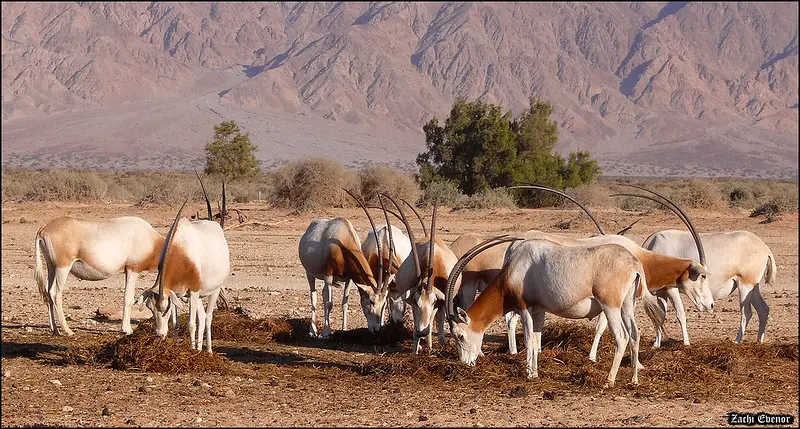
Scimitar Oryx
The scimitar oryx (Oryx dammah) is a species of antelope native to Africa. It has long horns that grow up to 50 inches long and are curved backward like a scimitar sword. Its body is characterized by thick white fur with black markings on the face, chest, legs, and back. The animal’s habitat includes deserts, semi-deserts, grasslands, and shrublands, where it feeds on foliage such as grasses and herbs during the wet season when vegetation is available.
In addition to its diet of quality vegetation, the scimitar oryx can go without water for days at a time due to its ability to conserve moisture from food sources. Furthermore, an interesting adaptation it has developed is thermoregulation; this helps prevent overheating while roaming in hot climates over large distances every day.
As recently as 2000, only 300 individuals were left in the wild due largely to unsustainable hunting practices encouraged by governments before 1960. Fortunately, since then, conservation efforts have increased significantly, resulting in restocking programs that have successfully returned several thousand animals to suitable habitats across North Africa—a success story for sure!
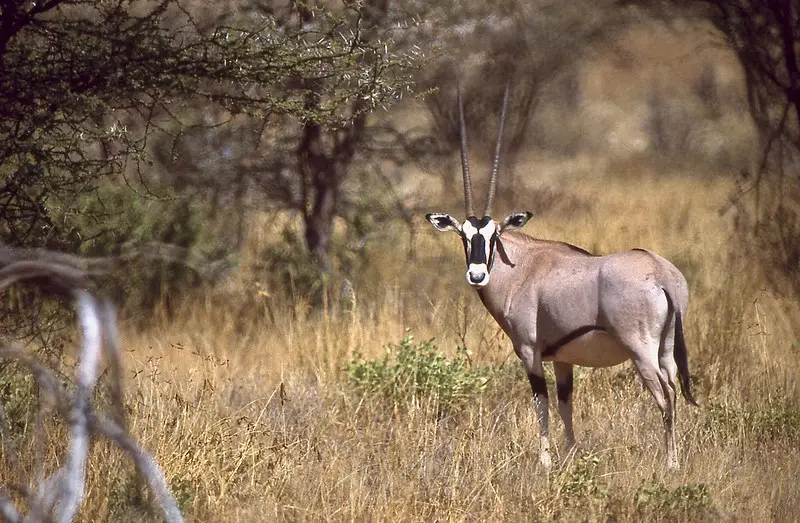
East African Oryx
The East African oryx (beisa oryx) is an antelope species in East Africa. It has long, straight horns and usually lives on dry grassland plains and shrublands. Its main predators are lions and hyenas, but humans have been known to hunt it for meat, sport hunting, and trophies.
This species is one of two subspecies that make up the scimitar-horned oryx (Oryx dammah). The other subspecies is called the northwest African oryx. Both subspecies can grow up to 6 ft tall at shoulder height and weigh between 200–300 lbs. Like many animals in its family, they tend to live in small herds consisting of males, females, calves, juveniles, and yearlings.
East African Oryx have adapted well to their environment by subsisting on minimal water intake due to increased efficiency when extracting moisture from plants; this allows them to survive during extended drought periods. They require little cover since they use their speed rather than camouflage for protection while grazing on open plains, making them vulnerable to hunters’ guns when not well protected.
However, conservation efforts have helped improve numbers across much of Kenya’s rangelands, where there had previously been overhunting due to lack of regulation leading to local extinctions in some areas.
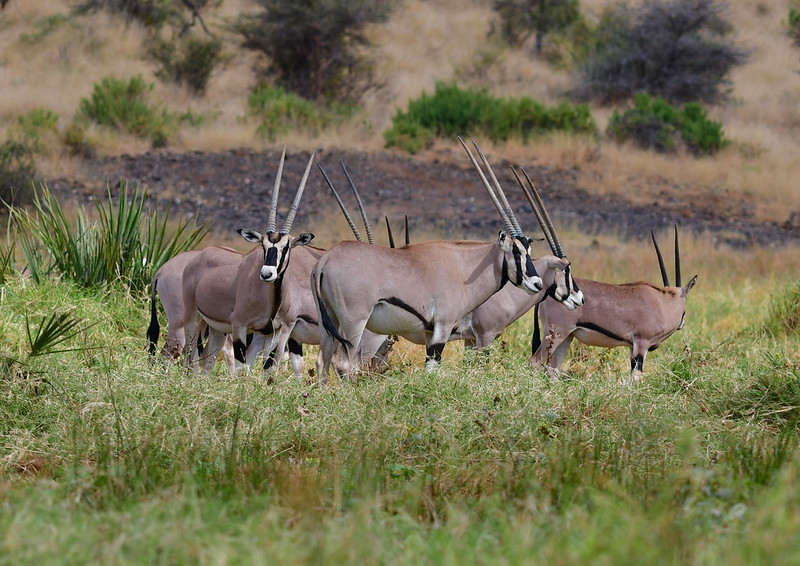
Common Beisa Oryx
The Common Beisa Oryx (Oryx gazella beisa) is a species of antelope native to the Horn of Africa and East Africa. It belongs to the genus Oryx, which includes four species of large antelopes with long horns that inhabit dry areas in Africa and Arabia. The Common Beisa Oryx is found mainly in Somalia, Ethiopia, Djibouti, and Kenya.
This species has adapted well to living in arid environments characterized by sparse vegetation, hot temperatures, and scarce water sources. They can go without drinking for several days or weeks, relying on moisture from their food sources. Their thick fur keeps them cool during the day and warm during the night, allowing them to survive harsh conditions efficiently.
Common Beisa Oryxes are typically seen alone or in pairs but may form small herds when more food is available. They often graze together with other ungulates, such as zebras and ostriches, while avoiding predators like lions and hyenas through their speed and agility. In addition to grazing on grasses, they eat leaves, flowers, and fruits depending on seasonality. Conservation efforts have helped increase its population significantly over recent years since it was previously categorized as Near Threatened due to hunting pressure and habitat loss caused by human activities.
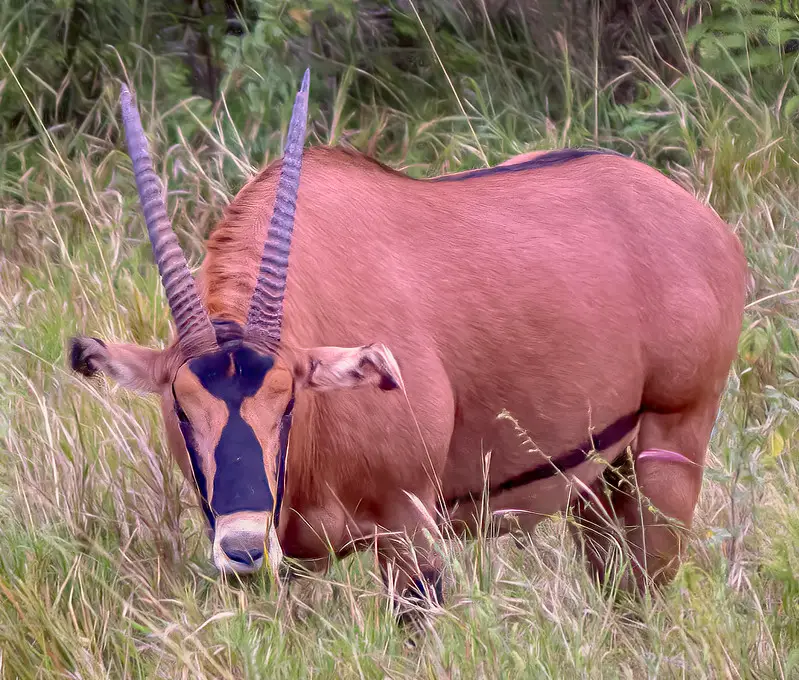
Fringe-Eared Oryx
The Fringe-eared Oryx is a species of antelope found in eastern Africa’s open plains and semi-arid regions. It is one of two subspecies of Beisa Oryx, the other being the Common Beisa Oryx. This species has two large horns, which form an impressive curved shape and have distinctive fringes along their edges. The body of this animal is mostly tan or gray, while its legs are white or cream-colored. Its face also displays black patches around the eyes, nose, and mouth.
This species prefers to live in small herds composed of males and females. They typically inhabit sparse vegetation, such as grasslands and savannas, where they feed on leaves, shoots, fruits, flowers, nuts, and insects. During dry seasons these animals can survive without water for extended periods by extracting moisture from plants that they consume. Additionally, they will dig holes to reach underground water sources when needed.
To protect itself against predators like lions and hyenas, the Fring-eared Oryx relies heavily on its keen senses combined with its ability to move quickly across long distances at speeds up to 25 mph (40 km/h). As a result, it can evade most potential threats before they become too close for comfort. In addition to running away from danger, this species will use its horns defensively if necessary.
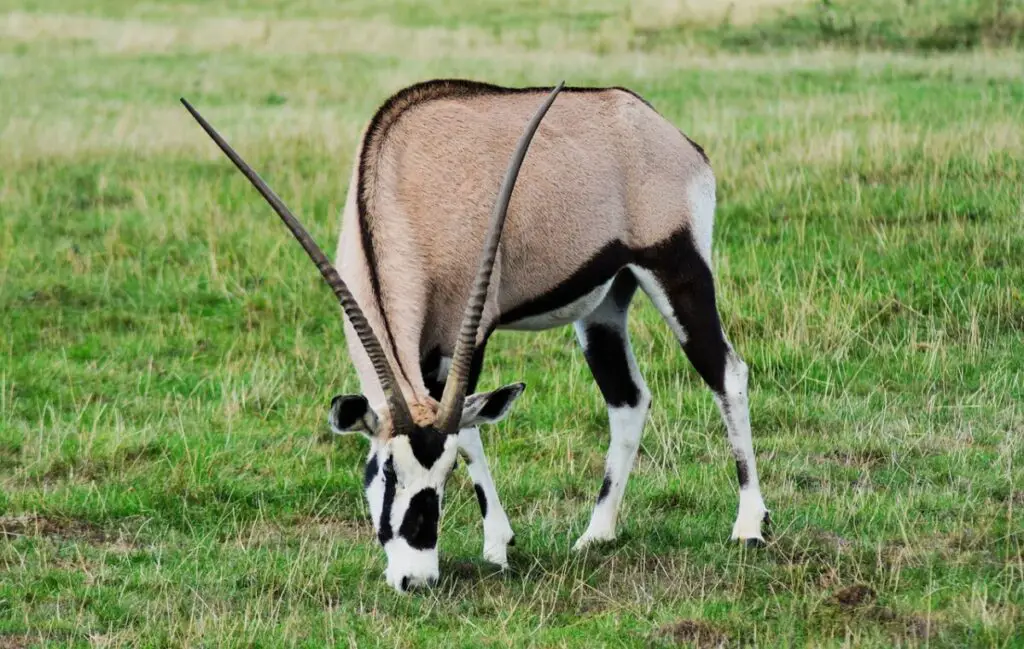
What Is A Gemsbok?
The gemsbok is a large antelope belonging to the Oryx genus, which includes four other species. It is native to the arid and semi-arid regions of southern Africa, including Namibia, Botswana, Angola, Zambia, and South Africa. The gemsbok has long horns curved backward in an S shape with sharp tips. Its coat is tawny grey or white with black patches on its legs and tail. This animal can reach up to 1.2 meters in shoulder height and weigh up to 250 kilograms.
Gemsboks have adapted well to their dry environment due to their ability to go for long periods without drinking water, as they obtain most of their moisture from plants. They feed mainly on grasses, herbs, and shrubs but occasionally eat insects. To stay cool during hot days, these animals move into areas with more shade, such as woodlands or trees near rivers or streams where temperatures are cooler than in open plains. Regarding behavior, gemsboks tend to be solitary, although males sometimes gather together in herds when competing for mates during mating season.
Gemsboks are hunted by humans for sport and food; however, populations remain stable due to their wide range across much of Southern Africa’s savannas and deserts, making it difficult for hunters to reduce numbers significantly within a given area over time.
Conclusion
The oryx is a fascinating creature. It is ungulate, which means it belongs to the same animal group as horses and antelopes. There are several species of oryx that can be found in different parts of Africa. The East African Oryx lives on grasslands and savannahs, while the Common Beisa Oryx inhabits scrublands and semi-deserts. The Fring-eared Oryx prefers open woodlands. Orxyes have large bodies with long horns and white markings against their brown pelts. Their name comes from the Greek word “sharp” because of their pointed horns.
Gemsboks belong to the same family as the oryx, but they live mainly in Southern Africa. While gemsboks and oryxes share similar physical characteristics, such as body size, coloring, hooves, and horn shape, they also differ. For example, gemsbok horns curve downwards, whereas those of an oryx point upwards in a straight line. In addition, gemsboks tend to inhabit more arid regions than do oryxes.
In conclusion, the oryx is an impressive mammal native to certain areas of Africa with several distinguishing features, including its long curved horns and light-colored patches on its fur coat. It shares many similarities with another member of its family, the gemsbok; however, there are also noteworthy distinctions between these two animals that set them apart. Despite this, they remain connected by being part of the same family: Bovidae –the bovine family– making them unique yet related simultaneously.
